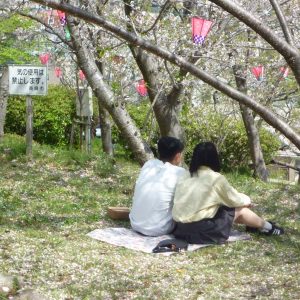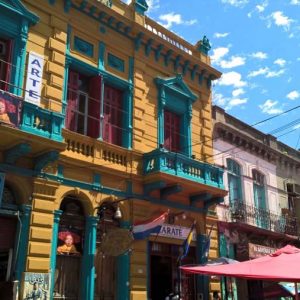A thunderstorm has broken over Munich but despite the lightning flashes and fierce rain we are tucking into asparagus with Wiener Schnitzel outside the lovely old Zum Dürnbräu restaurant, protected from the onslaught by a deep awning. The white spears are perfectly cooked. The Schnitzel is a side dish. The Germans take their asparagus very seriously. As at many eateries it merits its own menu. You can eat it on its own, with ham, for example, or Bratwurst. It comes with butter or Hollandaise sauce. In German it is Spargel – and it is always the star of the show.
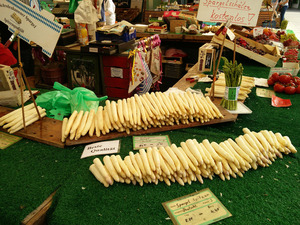 This is still Spargelzeit, the season that begins in mid April with boards outside restaurants announcing its arrival and ends on 24 June, the Feast Day of St John the Baptist. (I have an image of Salome bearing his head on a salver – with asparagus.) In those few weeks Germans consume an estimated 125,000 tonnes of it, often buying it from numerous roadside stalls. It is served in salads. At Munich’s up market Pfistermühle I ate it five ways, among them pickled and in a mousse. And later, in Regensburg, I was unable to resist asparagus ice cream – with strawberries. Surprisingly, this worked very well.
This is still Spargelzeit, the season that begins in mid April with boards outside restaurants announcing its arrival and ends on 24 June, the Feast Day of St John the Baptist. (I have an image of Salome bearing his head on a salver – with asparagus.) In those few weeks Germans consume an estimated 125,000 tonnes of it, often buying it from numerous roadside stalls. It is served in salads. At Munich’s up market Pfistermühle I ate it five ways, among them pickled and in a mousse. And later, in Regensburg, I was unable to resist asparagus ice cream – with strawberries. Surprisingly, this worked very well.
Though they still eat the green variety, their main preference switched long ago to white, which is grown under mounds of earth until the tips emerge into daylight. In Bavaria it’s often billed as Schrobenhausener asparagus. The Roman town of Schrobenhausen, near Augsburg, lies at the centre of a huge cultivation area whose loose sandy soil is said to give the local variety its light, nutty flavour. It even has a museum dedicated to asparagus.
The Romans are thought to have introduced the vegetable. It is tempting to see it as a kind of leitmotif, a thread connecting the patchwork of Kingdoms, Duchies – grand or otherwise – electorates and principalities etcetera that eventual emerged into present day Germany. And after that as a constant in the country’s more recent past. Hitler enjoyed it, though I like to imagine him suffering the overcooked, tasteless asparagus served to me at a restaurant near Munich’s excellent Jewish Museum, which makes such a noble effort to bridge the comprehension gap between today’s pleasant, civilised, multicultural city and its Nazi connections. 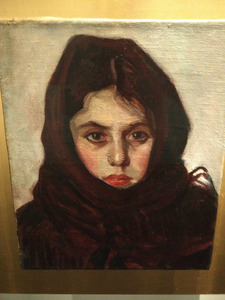 A highlight is Girl from the Ghetto, a wonderful preliminary study, painted in 1915 by Polish artist Stanislaus Bender, which survived his family’s forced emigration in 1939.
A highlight is Girl from the Ghetto, a wonderful preliminary study, painted in 1915 by Polish artist Stanislaus Bender, which survived his family’s forced emigration in 1939.
It’s not known whether Wassily Kandinsky was an asparagus lover, though there’s a record of his fellow artist August Macke eating it in Tunisia. They were both members of Der Blaue Reiter group, which also included Paul Klee and Franz Marc. To Hitler it was ‘Entartete Kunst’ – degenerate art – and was the subject of a sneering 1938 exhibition. My wife and I renew our acquaintance with it at the Lenbachhaus, marvelling at Kandinsky’s bold experiments. Then we go looking for the address in Schwabing, where he lived and worked with the expressionist painter Gabriele Münter. We find a plaque on the wall of an uninspiring apartment block on Ainmiller Strasse, where some splendid Art Deco facades survived the allied bombing that caused such widespread damage. It records that they lived there for around six years from 1908. Not long afterwards they split up. During the Second World War Münter she took the risk of hiding works by him and other Blaue Reiter members at her home in Murnau, south of Munich, where she and Kandinsky had spent the summer months. Though the house was searched they weren’t found. On her 80th birthday she gave almost all of them – over 80 paintings and 330 drawings – to the Städtische Galerie in the Lenbachhaus, where that terrific collection remains.
Schwabing, towards the north of the city, includes the university. Full of boutiques and cafes it has long been a magnet for writers, artists and intellectuals, among them the author Thomas Mann. On the street where Kandinsky and Münter lived is another plaque, marking the former residence of the poet Rainer Maria Rilke. We walk east past Bapas, a cafe and bar serving ‘Bayerische Tapas’, admiring increasingly desirable villas, to the great green spaces, streams and shaded avenues of the Englischer Garten, heading in late afternoon for one of Munich’s most popular beer gardens, where hundreds gather in hot sunshine under the horse chestnut trees. 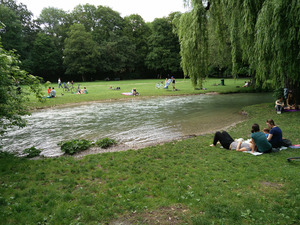 They listen to the band, oompahing away from a stage on the Chinese Tower and regularly launching, as they have umpteen times, into the drinking toast “Ein Prosit, ein Prosit, der Gemütlichkeit”. And they snack on sausages and grilled chicken before eventually returning their beer glasses and collecting the deposit charged to prevent people walking off with them.
They listen to the band, oompahing away from a stage on the Chinese Tower and regularly launching, as they have umpteen times, into the drinking toast “Ein Prosit, ein Prosit, der Gemütlichkeit”. And they snack on sausages and grilled chicken before eventually returning their beer glasses and collecting the deposit charged to prevent people walking off with them.
The walk across the park, back to the Universität underground station, is in pleasant contrast to the tourist thronged old town, though you feel obliged to take in the Frauenkirche, Munich’s cathedral, with its characteristic twin onion domed towers, and to join the crowds in the Marienplatz watching the Glockenspiel display at the New Town Hall. Mounted knights joust on the top level and below them uncannily realistic figures perform the Schäfflertanz, or coopers’ dance, whose origin is said to date from a 16th century outbreak of plague. Nor should you fail to wander around the Viktualenmarkt, where shops and stalls sell all manner of meat, fungus and vegetables, including, at the appropriate time of year, neat, graded stacks of the inevitable asparagus.
Packing as much as possible into a few days we take in the Residenz, the palace of Bavaria’s Wittelsbach monarchs, much restored after war damage, visit the Deutsches Museum with its fine collection of vintage boats and aircraft, and stroll along the River Isar, where locals sunbathe on hot summer days.
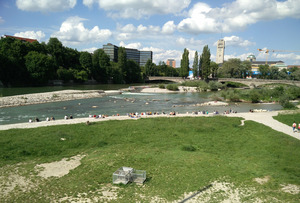 Back on the Marienplatz we encounter a rally organised by Pegida – Patriotic Europeans Against the Islamisation of the Occident. An opposing group tries to drown the voices of its speakers with vuvuzelas and chants of “Racists aus”. With Bavarian elections taking place this Autumn and, as I write, Angela Merkel under pressure to turn back migrants, it’s a sharp reminder that tensions persist in that apparently contented population.
Back on the Marienplatz we encounter a rally organised by Pegida – Patriotic Europeans Against the Islamisation of the Occident. An opposing group tries to drown the voices of its speakers with vuvuzelas and chants of “Racists aus”. With Bavarian elections taking place this Autumn and, as I write, Angela Merkel under pressure to turn back migrants, it’s a sharp reminder that tensions persist in that apparently contented population.
Whatever happens, of course, the annual ritual of Spargelzeit will keep rolling around, regardless. I leave Munich hoping that, in this city of many marvels, there’s no bitter taste to mar the enjoyment of it.
Tips: check www.mvv-muenchen.de for public transport price. For example, a 3 day group ticket for up to 5 adults costs €29.60, or about £4.50 per day for each of two and covers underground trains, buses and tams across most of the area you’ll nee to see. There’s also an airport ticket than includes city travel for the rest the day of arrival or departure.
We stayed at the pleasant Hotel Admiral, which is within easy walking distance of the old town and a stone’s throw from the River Isar and the Deutsches Museum.
For city breaks Silver Travel Advisor recommends Kirker Holidays.

